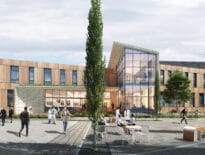
Matthew Pullen
Early last year, I discussed the emergence of brand-new life science clusters outside of Cambridge, Greater Boston’s traditional innovation hub. Seeking to accommodate Cambridge’s overflow of tenant demand, laboratory developers were emerging as some of the most active bidders on land sites throughout the region.
This year, the COVID-19 pandemic has served as an accelerant for this trend by emphasizing the critical importance of the life science sector. In parallel, it has acted as an accelerant for the region’s predominant industrial trend, rapidly increasing demand for “last mile” distribution facilities located in densely populated suburbs with swift access to the urban core.
The life science and industrial sectors are therefore undergoing a convergence with tenants from both groups – especially those with the primary users of this inventory: biomanufacturing, research and development, e-commerce and logistics firms – racing to establish a footprint across the region’s suburbs. Biotechnology manufacturing requirements, which represent the epitome of the life science–industrial convergence, are particularly active.
This influx of demand has resulted in the need for new supply. Consequently, investors are pursuing land sites as well as evaluating existing properties for their ability to add massing on excess land or convert in-place facilities for life science industrial use.
Suburban properties that offer swift access to both the urban core and abundant local amenities present the most attractive value proposition for life science and industrial tenants alike.
Life science users with biomanufacturing and R&D requirements seek access to their Cambridge-based headquarters facilities. They also prioritize proximity to amenities that provide their employees with opportunities for collaboration.
Industrial users with e-commerce and logistics requirements seek access to major distribution corridors and densely populated residential communities. Local amenities serve as anchors for these residential communities, populating the surrounding area with potential customers.
Route 128 in Focus
Driven by its proximity to the urban core and wealth of well-established, amenity-rich, mixed-use clusters, the Route 128/Interstate 95 corridor serves as the primary destination for life science and industrial users seeking to plant a flag in the suburbs. Those with biotechnology manufacturing requirements are particularly focused on pursuing locations along this corridor.
Acquisition opportunities – both land sites and existing properties with life science/industrial use or development/conversion potential – along the corridor, therefore, are enjoying strong buyer interest. Properties that have been recently sold or are currently on the market include:
- 11 Centennial Drive, a warehouse building that handles the distribution of pharmaceuticals to pharmacies and hospitals across the region from Peabody
- 1 Upland Road, a renovate-to-suit asset for a biotechnology firm with expansion potential in Norwood
- The Post, a life science/office complex with potential for increased density in Waltham
- Reservoir Woods East, a synergistic campus with life science development potential in Waltham
- 480 Sprague St., a “last mile” logistics hub in Dedham
- 3 Technology Drive, a modernized warehouse/distribution facility in Peabody
- 825 University Ave., an office, manufacturing and R&D complex with laboratory/office expansion potential in Norwood
Additional Opportunities Abound
The proliferation of life science and industrial tenants competing for space across Greater Boston’s suburbs presents exceptional opportunities for the development of previously overlooked land sites or the repositioning of existing properties to accommodate these users. Properties in the right locations and with the appropriate infrastructure are especially well positioned for conversion into biotechnology manufacturing use.
This trend also presents opportunities for assets outside of the life science and industrial sectors. Office developments can be positioned to accommodate support functions for these users, while retail and multi-family developments are necessary for establishing the amenity-rich environments toward which these tenants gravitate.
Finally, this outsized tenant demand and its anticipated positive impact on suburban vacancy and rental rates is expected to further secure Greater Boston’s positioning as one of the most sought-after markets in the United States. The region’s strong fundamentals are particularly attractive in the wake of the COVID-19 pandemic, which has reinforced the critical importance of core investments in “safe harbor” markets with resilient economies.
Matthew Pullen is an executive managing director at Newmark.






